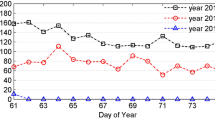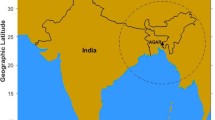Abstract
With the increased number of low Earth orbit (LEO) satellites equipped with global navigation satellite system (GNSS) receiver, the LEO based GNSS slant total electron content (TEC) and electron density profile (EDP) data play an increasingly important role in space weather and ionospheric research due to improved global coverage. China Seismo-Electromagnetic Satellite (CSES), which was launched in February 2018, is equipped with GNSS receiver for either precise orbit determination (POD) and ionospheric inversion. The purpose of the present paper is to validate CSES GNSS ionospheric inversion technique based on the real observations and verify the accuracy of TEC and EDP retrieval based on the simulated data. The following conclusions can be drawn: the epoch difference inversion (EDI) derived from CSES can successfully retrieve the EDPs without non-occultation side measurements; the technique of EDI and the calibrated TEC inversion (CTI) have similar behaviors in inversion errors, however, the retrieved NmF2 and hmF2 have a larger systematic error surrounding the equatorial ionization anomaly (EIA) where the assumption of spherical symmetry is often invalid; the precision and accuracy of retrieved TEC have been investigated in the paper based on the simulated data, and it is found that the accuracy of the retrieved TEC is relative to solar activity: the lower the F10.7 index, the higher the accuracy of retrieved TEC.
Similar content being viewed by others
References
Shen X H, Zhang X M, Yuan S G, et al. The state-of-the-art of the China seismo-electeomagnetic satellite mission. Sci China Tech Sci, 2018, 61: 634–642
Cao J B, Zeng L, Zhan F, et al. The electromagnetic wave experiment for CSES mission: Search coil magnetometer. Sci China Tech Sci, 2018, 61: 653–658
Chen B J, Zhou B, Magnes W, et al. High precision magnetometer for geomagnetic exploration in China Seismo-Electromagnetic Satellite. Sci China Tech Sci, 2018, 61: 659–668
Ambrosi G, Bartocci S, Basara L, et al. The HEPD particle detector of the CSES satellite mission for investigating seismo-associated perturbations of the Van Allen belts. Sci China Tech Sci, 2018, 61: 643–652
Zhu F Y, Wu Y. Anomalous variations in ionospheric TEC prior to the 2011 Japan Ms9.0 earthquake. Geodesy Geodyn, 2011, 2: 8–11
Yang J, Zhou Y F, Su F F. Ionospheric anomaly before the 2011 Tohoku Mw 9.0 earthquake. Geodesy Geodyn, 2012, 3: 17–22
Li Z, Yuan Y, Li H, et al. Two-step method for the determination of the differential code biases of COMPASS satellites. J Geodyn, 2012, 86: 1059–1076
Zhang D H, Zhang W, Li Q, et al. Accuracy analysis of the GPS instrumental bias estimated from observations in middle and low latitudes. Ann Geophys, 2010, 28: 1571–1580
Zhang W, Zhang D H, Xiao Z. The influence of geomagnetic storms on the estimation of GPS instrumental biases. Ann Geophys, 2009, 27: 1613–1623
Choi B K, Cho J H, Lee S J. Estimation and analysis of GPS receiver differential code biases using KGN in Korean Peninsula. Adv Space Res, 2011, 47: 1590–1599
Schreiner W S, Sokolovskiy S V, Rocken C, et al. Analysis and validation of GPS/MET radio occultation data in the ionosphere. Radio Sci, 1999, 34: 949–966
Wu X C, Hu X, Zhang X X, et al. A calibrated TEC technique for inversion of ionospheric GPS occultation data (in Chinese). Chin J Geophys, 2006, 49: 328–334
Lei J, Syndergaard S, Burns A G, et al. Comparison of COSMIC ionospheric measurements with ground-based observations and model predictions: Preliminary results. J Geophys Res, 2007, 112: A07308
Yue X, Schreiner W S, Rocken C, et al. Artificial ionospheric wave number 4 structure below the F2 region due to the Abel retrieval of radio occultation measurements. GPS Solut, 2012, 16: 1–7
Yue X, Schreiner W S, Rocken C, et al. Evaluation of the orbit altitude electron density estimation and its effect on the Abel inversion from radio occultation measurements. Radio Sci, 2011, 46: RS1013
Lin J, Xiong J, Zhu F, et al. An ionospheric occultation inversion technique based on epoch difference. J Atmos Sol-Terr Phys, 2013, 102: 192–197
Braasch M. Multi-path effects. In: Parkinson B W, Spilker J J, eds. Global Positioning System: Theory and Applications, vol 1. Progress in Astronautics and Aeronautics. American Institute of Aeronautics and Astronautics, Reston, 1996. 547–568
Blewitt G. An automatic editing algorithm for GPS data. Geophys Res Lett, 1990, 17: 199–202
Yue X, Schreiner W S, Hunt D C, et al. Quantitative evaluation of the low Earth orbit satellite based slant total electron content determination. Space Weather, 2011, 9: 09001
Lin J, Wu Y. Abel ionospheric inversion technique and itserror analysis (in Chinese). Chin J Geophys, 2013, 56: 1070–1076
Lin J, Yue X, Zhao S. Estimation and analysis of GPS satellite DCB based on LEO observations. GPS Solut, 2016, 20: 251–258
Foelsche U, Kirchengast G. A simple “geometric” mapping function for the hydrostatic delay at radio frequencies and assessment of its performance. Geophys Res Lett, 2002, 29: 111-1–111-4
Yue X, Schreiner W S, Lei J, et al. Error analysis of Abel retrieved electron density profiles from radio occultation measurements. Ann Geophys, 2010, 28: 217–222
Montenbruck O, Kroes R. In-flight performance analysis of the CHAMP BlackJack GPS Receiver. GPS Solutions, 2003, 7: 74–86
Mendillo M, Schatten K. Influence of solar sector boundaries on ionospheric variability. J Geophys Res, 1983, 88: 9145–9153
Rishbeth H, Mendillo M. Patterns of F2-layer variability. J Atmos Sol-Terr Phys, 2001, 63: 1661–1680
Author information
Authors and Affiliations
Corresponding authors
Rights and permissions
About this article
Cite this article
Lin, J., Shen, X., Hu, L. et al. CSES GNSS ionospheric inversion technique, validation and error analysis. Sci. China Technol. Sci. 61, 669–677 (2018). https://doi.org/10.1007/s11431-018-9245-6
Received:
Accepted:
Published:
Issue Date:
DOI: https://doi.org/10.1007/s11431-018-9245-6




